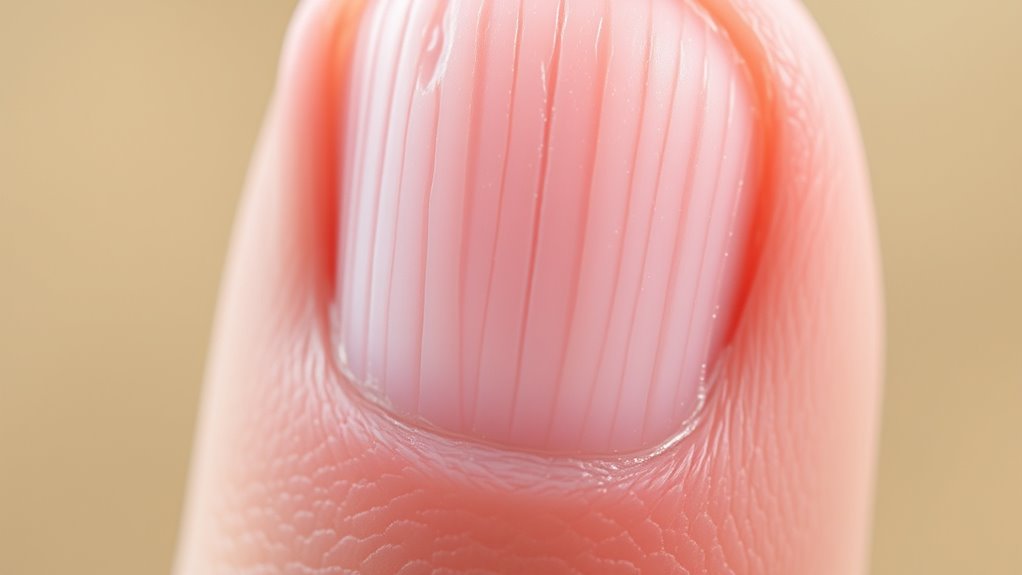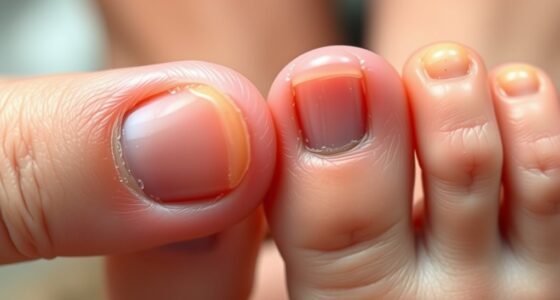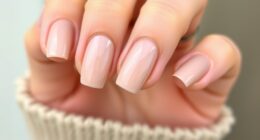Nails develop ridges due to a variety of factors, including natural aging, nutritional deficiencies like biotin or zinc shortages, dehydration, or health issues such as thyroid problems or anemia. Vertical ridges often come from aging or minor growth variations, while horizontal ridges (Beau’s lines) can signal recovery from stress, illness, or injury. External damage, chemicals, or skin conditions may also cause ridges. Continue exploring to uncover the specific causes behind your nail changes and how to improve them.
Key Takeaways
- Vertical ridges are common with aging and often indicate minor variations in nail growth or nutritional deficiencies.
- Horizontal ridges, or Beau’s lines, result from temporary disruptions due to illness, stress, or injury.
- Nutritional deficiencies like zinc, iron, or biotin can weaken nails and cause ridges.
- External factors such as harsh chemicals, dehydration, and skin conditions may contribute to ridge formation.
- Ridges can signal underlying health issues, so persistent or unusual changes should be evaluated by a healthcare professional.

Nail ridges are visible lines that run vertically or horizontally across your nails, and they often signal underlying health issues or aging processes. While some ridges are harmless and simply part of aging, others can indicate changes in your body’s health. Understanding what causes these ridges can help you address cosmetic concerns and maintain good nail health.
Vertical ridges, which run from the cuticle to the tip, are quite common as you age. They tend to develop gradually and are usually harmless, often reflecting natural aging or minor variations in nail growth. However, persistent or pronounced vertical ridges might suggest nutritional deficiencies, dehydration, or underlying health conditions like anemia or thyroid issues. If you notice abrupt changes in your nail texture or if ridges become more prominent, it’s wise to consult a healthcare professional to rule out medical concerns.
Vertical ridges are common with age but may signal nutritional deficiencies or health issues if they become pronounced.
Horizontal ridges, also called Beau’s lines, are different and often more concerning. These ridges run across the nail and can appear after periods of physical or emotional stress, illness, or injury. They may also indicate more serious health issues, such as infections, diabetes, or zinc deficiency. Because they interrupt normal nail growth, Beau’s lines can be a sign that your body is recovering from a significant stressor or that a chronic health condition needs attention. If you see these ridges, especially if they are accompanied by other symptoms, you should seek medical advice to address the root causes.
Nail health can be affected by a range of factors, from simple aging to more complex health conditions. For example, nutritional deficiencies—like lack of biotin, iron, or zinc—can weaken nails and promote ridges. Similarly, dehydration and exposure to harsh chemicals or frequent manicures can damage the nail surface, making ridges more noticeable. On the other hand, certain skin conditions, such as psoriasis or eczema, can also impact nail health and create ridges or other abnormalities. Additionally, indoor air quality can influence nail and skin health, as poor air quality may exacerbate skin conditions that affect nails.
While some ridges may be purely cosmetic, they can sometimes cause concern about the appearance of your nails. If you’re worried about how your nails look, or if ridges are accompanied by changes in color, texture, or thickness, it’s important to evaluate your overall health and lifestyle. Proper nail care—including moisturizing, gentle handling, and a balanced diet—can help keep your nails healthy and reduce cosmetic concerns. Ultimately, recognizing the causes behind nail ridges allows you to take proactive steps for both your nail health and your confidence.
Frequently Asked Questions
Can Nail Ridges Indicate Serious Health Problems?
You might wonder if nail ridges signal serious health issues. Generally, vertical ridges are common and linked to aging or minor nail health changes. However, if you notice horizontal ridges, changes in color, or other symptoms, it could indicate underlying medical concerns like nutritional deficiencies or systemic conditions. Always consult a healthcare professional to evaluate your nails properly, especially if you experience pain or significant changes, to address any potential medical concerns.
Do Nail Ridges Affect Nail Strength or Growth?
You might wonder if those nail ridges are weakening your nails or slowing their growth. The truth is, mild ridges usually don’t affect nail strength or growth considerably—they’re often just a sign of natural aging or minor health changes. However, deep or pronounced ridges could hint at underlying issues. Keep an eye on your nails, and if you notice drastic changes, consult a healthcare professional to ensure your nails stay healthy and strong.
Are There Home Remedies to Reduce Nail Ridges?
You can try simple home remedies and natural treatments to reduce nail ridges. Keep your nails moisturized by applying vitamin E oil or coconut oil regularly. Gentle buffing with a soft nail file can smooth out ridges. Eating a balanced diet rich in biotin and staying hydrated also supports healthy nails. Remember, consistency is key, and if ridges persist or worsen, consult a healthcare professional for proper diagnosis and treatment.
How Long Does It Take for Ridges to Grow Out?
Imagine your nails as a story unfolding; the growth timeline varies, but typically, ridges take about 6 months to grow out completely. Your nail cycle, which includes growth and shedding, influences this process. While minor ridges may disappear sooner, deeper ones might need more time. Patience is key, and maintaining good nail health can help speed up the process. You’ll see results as your new, smooth nails emerge.
Are Nail Ridges More Common in Certain Age Groups?
You might notice nail ridges more often as you age, especially in older adults. Aging factors naturally lead to more prominent ridges, and genetic predisposition can make some people more prone regardless of age. Younger individuals usually have smoother nails, but these ridges become more common over time. If you see changes, it’s often linked to aging factors or genetics, though persistent or unusual ridges should prompt a check with your doctor.
Conclusion
So, next time you notice those ridges running down your nails, don’t panic—your body’s way of telling you something’s up. Ironically, while these lines seem like imperfections, they often reveal your health’s story, for better or worse. Instead of ignoring them, pay attention and consult a professional if needed. After all, those ridges might just be nature’s way of reminding you that even your nails have something to say—if only you’d listen.









